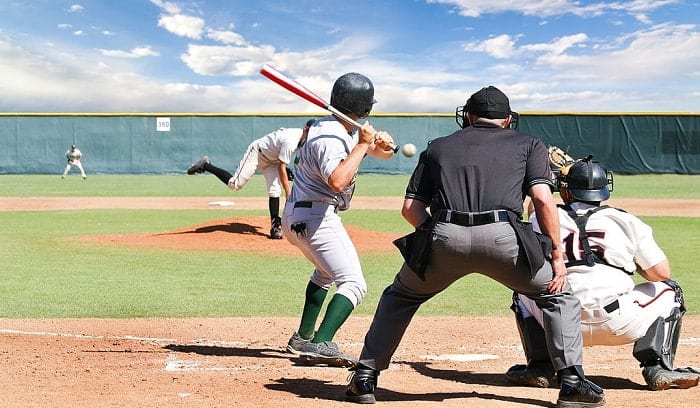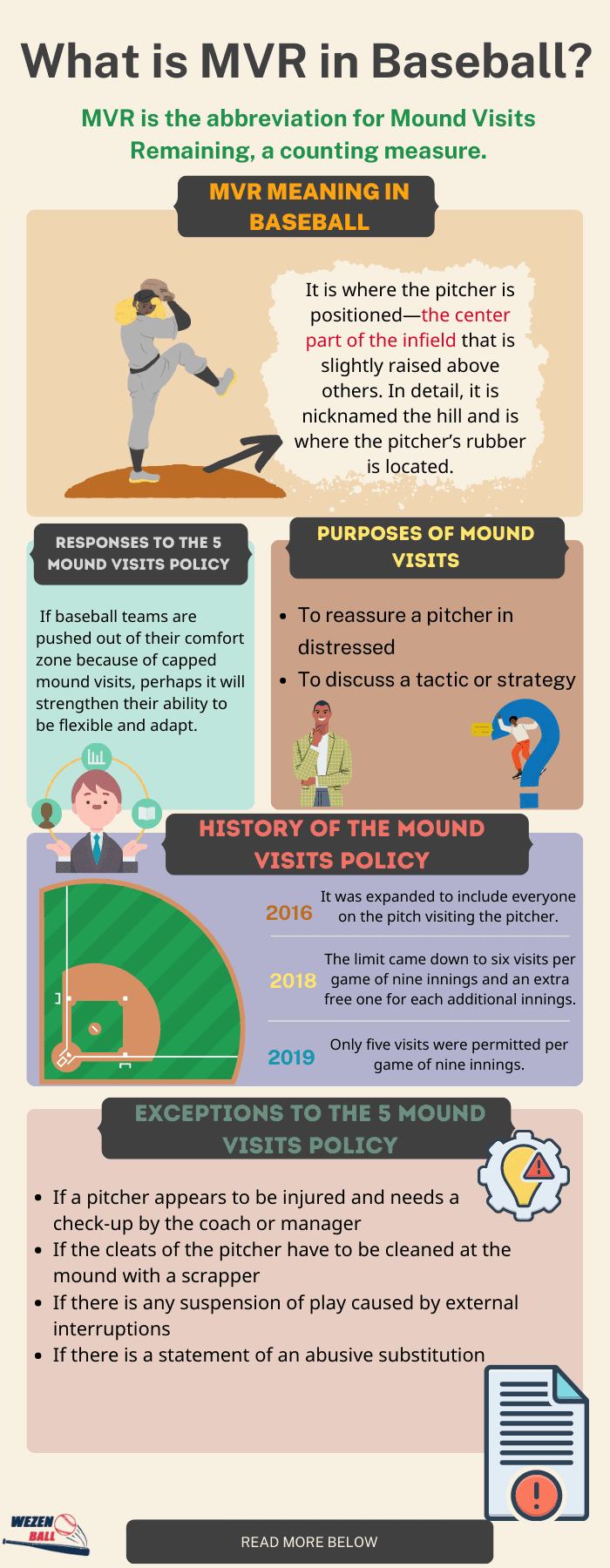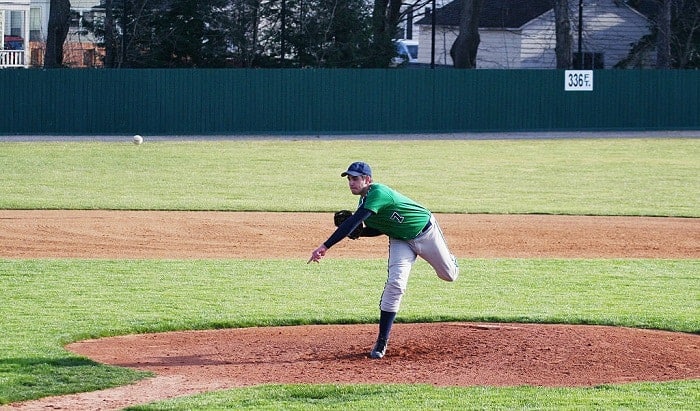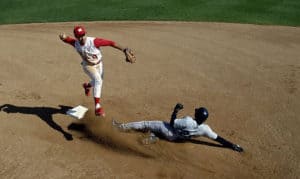If you are a hardcore baseball fan, you may know all the lingo by heart. However, if you are new to baseball and want to learn the language one word at a time, this article on “what is MVR in baseball” is a good place to start.
It is important to know what MRV is in order to read a baseball scoreboard and get the most out of a game. Even though it is featured next to R, H, and E—Runs, Hits, and Errors—MVR baseball stat is not really a data.
Instead, MVR is the abbreviation for Mound Visits Remaining, which is a counting measure. In this article, we will explain what MVR stands for in baseball and delve deeper into details so you can be more informed of the topic as a whole. Join us in exploring this part of the baseball realm!
We will take you through:
- The meaning of MVR in baseball
- The exceptions to 5 mound visits per game
- The reasons for/purposes of mound visits
- The history of mound visits (2016-2019)
- The reactions/responses to mound visits
Happy reading!
Contents
What is MVR in baseball/ MVR Meaning in Baseball?
As briefly mentioned above, MVR stands for Mound Visits Remaining. You may have seen this abbreviation on the scoreboard in Major League baseball games. To fully understand it, we will dissect the term, starting with mound.
This is sometimes also spelled as mount. It is where the pitcher is positioned—the center part of the infield that is slightly raised above others. In detail, it is nicknamed the hill and is where the pitcher’s rubber is located. In any baseball game, the pitcher has to touch this rubber with his or her pivoting foot when preparing and delivering pitches.
Hence, visits refer to when someone, like a coach or manager, enters the field to speak with the pitcher without taking him or her away from the game.
The person visiting can initiate a normal conversation for 30 seconds after informing and getting permission from the umpire. The countdown begins from the moment he or she leaves the dugout. A visit wraps up when the said person goes out of the 18-foot circle around the pitching rubber.
Typically, one mound visit is allowed per pitcher and per inning. By this token, a pitcher will be removed from the game if he or she is visited twice in an inning. Usually, protocols will also eject the visiting figure, regardless of whether it is a coach or manager.
Teams are given five mound visits per nine innings in total. Plus, a visit for each additional innings played.
Now that we know what mound and visit entail, we can put it together while remaining to grasp the meaning of MVR as a whole. Remaining implies that MVR, in baseball, is an indicator for the number of mound visits a team has left to prevail.
Exceptions to the 5 Mound Visits Policy
By law, a team has only five visits per game. However, exceptions can be made in the following cases:
- If a pitcher appears to be injured and needs a check-up by the coach or manager
- If the cleats of the pitcher have to be cleaned at the mound with a scrapper
- If there is any suspension of play caused by external interruptions
- If there is a statement of an abusive substitution
Sometimes, a player or catcher can also visit the pitcher. For example when a cross-up occurs (Meaning: The pitcher does not throw the pitch that the catcher called). For instance, a catcher may be expecting a curveball, but they are hit with a fastball.
This is not an unfamiliar sight in baseball because complex signals and communicating sequences are bound to be ineligible from time to time.
Another instance is when a current player at bat is replaced, and the new pinch hitter comes into the field. He or she may want a quick meet to exchange with the pitcher.
Purposes of Mound Visits
The two most common reasons for mound visits are:
- To reassure a pitcher in distressed
- To discuss a tactic or strategy
Baseball is as stressful as any other sport. So, it is not a surprise when a pitcher becomes troubled at his or her position. In such cases, the coach or manager will make a mound visit to give a pep talk and try to calm or reassure the pitcher.
Throughout a game, there are many moments where strategic decisions are of utmost importance. The fate of an entire team can depend on the pitcher’s single throw. Thus, it is typical for a coach or manager to visit with the pitcher and denote a specific strategy.
History of The Mound Visits Policy
The restriction upon mound visits is relatively new. It was started in 2016 by Major League Baseball to minimize the times a game is put on hold because someone visits the mound. Needless to say, without a cap on mound visits, games will be longer.
There have been noticeable changes between 2016 and 2019, as follows:
2016
In 2016, mound visits only included those from the dugouts by a coach or manager. Later, in the same year, it was expanded to include everyone on the pitch visiting the pitcher.
2018
In 2018, the limit came down to six visits per game of nine innings and an extra free one for each additional innings.
2019
In 2019, only five visits were permitted per game of nine innings. But any conversations between an infield player and pitcher where they did not leave their positions were not counted as mound visits. It has continued to be that way until today.
Responses to the 5 Mound Visits Policy: Yay or Nay
The mound visits policy keeps games to a manageable duration, which is commendable for the health of the players as well as the audience. It gives the sport a more structured regime and an overall plus for management.
However, it is not so favorably applauded by traditional fans, players, coaches, and managers. There have been many complaints about the new restrictions in place. It is argued to mess up pre-determined ways of playing, forcing all agents involved to put in more time and effort. If not careful, a pitcher can be removed. and a coach or manager can be ejected. In fact, there is a whole debate around whether the MVR is necessary.
But, as with most things in life, change is inevitable. If baseball teams are pushed out of their comfort zone because of capped mound visits, perhaps it will strengthen their ability to be flexible and adapt.
Conclusion
You have reached the end of this article on what is MVR in baseball. Hopefully, you have picked up a lot of valuable information on this topic of baseball terms and lingo. You should no longer be stumped over what MVR means in baseball.
To recap, MVR is short for Mound Visits Remaining, which is a counting measure for the number of mound visits a team has left to prevail. You should now be aware of the exceptions, purposes, history, and responses to this three letter abbreviation.
If you have any other follow-up questions or thoughts regarding this, feel free to let us know in the comments. We are always super delighted to hear from our readers. Also, do not hesitate to share this with others!

Five years as a baseball player, my training approaches with this game give me the motivation to inspire and support young players more. Like all sports, we should start with the desire to have fun and maintain our resilience to strive better at any competition. But, of course, some of us want to have some fun and train for better health. It does not matter what your initial purpose is; I believe that most people ever holding on to the baseball bat will fall in love with the games as I do.

















